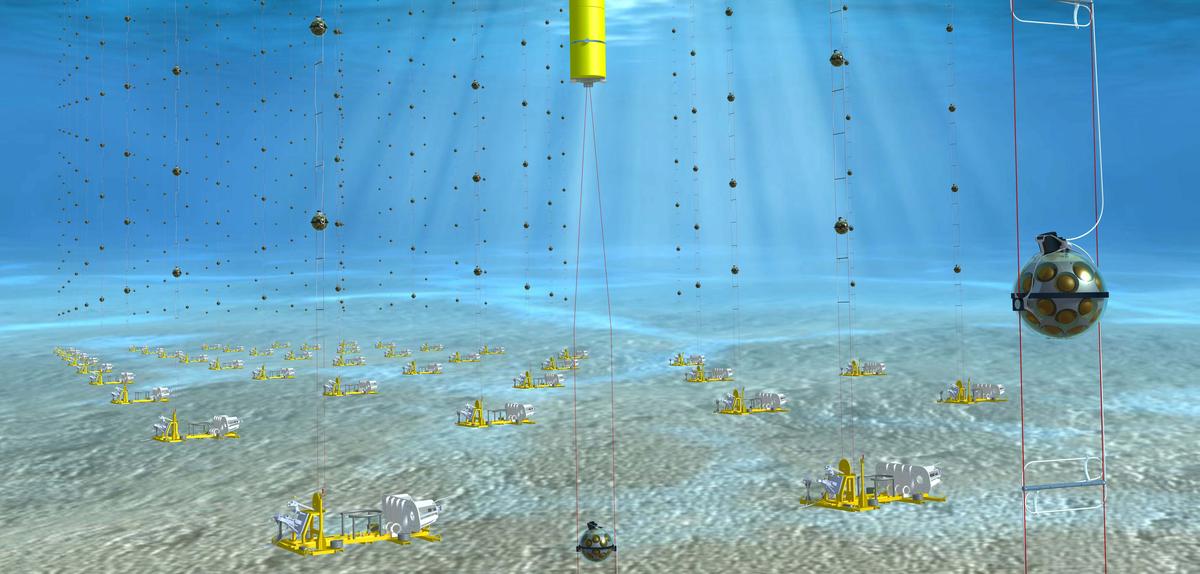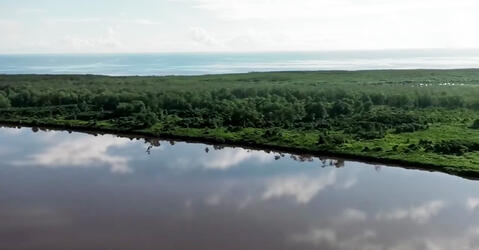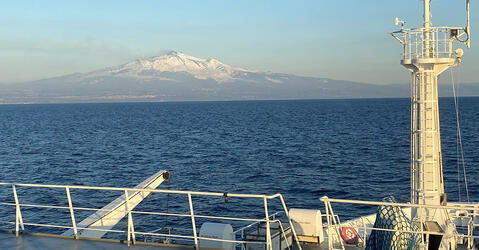You are here
A final checkup before the launch!
This unusual contraption, is on its way to the bottom of the Mediterranean sea.
Once submerged, 2500 meters below the surface, it’s going to be connected to a sprawling network of scientific instruments deployed over the last few years.
ITV Vincent
It’s quite an operation - and it’s one of the first steps in installing our new detector at the bottom of the sea. So we’re pretty excited. We are a bit nervous as well, because all operations like these are risky. You need to coordinate several elements at the same time, several boats, underwater robots… but we’re confident things will work out. We’re working with professionals here. The crew of the ship and the team working the robot. Things should be just fine.
The team is deploying what is known as a “detection line” - a key component of KM3NeT - a particularily ambitious scientific instrument. Once fully installed at the bottom of the sea, 40 kilometers from the city of Toulon, the detector will enable scientists to study some of Nature’s most mysterious particles: neutrinos.
ITV Paschal Coyle (voice over) :
Neutrinos have no charge, their mass is very close to 0, and they only interact through the weak interaction ; to some extent, they are the closest to nothing that you can get. That makes them incredibly difficult to detect and this is the reason we have to build these absolutely enormous detectors just to have a chance to detect an handful of neutrinos as they pass. So millions of neutrinos will pass through the detector and just a few of them will actually interact. And those precious neutrinos are what we spend many years of our lives trying to detect and understand.)
Neutrinos are created by nuclear reactions like those going on in the center of our Sun. Other sources include violent cosmic phenomena like the explosion caused by the death of a star…
These particles interact so little with the matter around us that billions of neutrinos fly through the Earth and our bodies each and every second with no effect. To increase the odds of observing the interaction between a neutrino and matter, one needs as much of it as possible. And there’s no bigger source of matter available to us than that beneath our feet.
Once a neutrino interacts with Earth, it produces a secondary particle called a muon. As it travels through the seawater, this muon will produce a cone of bluish light that can then be detected by the many light sensors, or optical modules, of the instrument.
These strings of optical modules need to be placed at precise locations on the sea bed.
----
Flashback to three years ago, at the CPPM, the Particle Physics Center of Marseille. THis is where the strings of optical modules are assembled into what looks like a ball of yarn. This operation can take weeks.
Each optical module is made up of 31 photomultipliers - light sensors so sensitive that they can detect a single photon.
This peculiar configuration enables the team to carefully place the line onto the seabed before letting it unravel all at once.
The spherical cage can then be salvaged and reused for one of the many successive lines to be deployed on this site
ITV Sylvain Henry (sur bateau)
One of the things we really need to do before sending the line into the water is to check the cables crisscrossing around the optical module. You need to carefully check each configuration, that the cable is correctly placed, that it’s not snagged anywhere, that there’s no strange loop - like the one you see here. This is something we need to fix because it can be a source of problems. These are the last minute verifications we have to carry out.
Once placed on the sea bed, the line is then connected to the junction box, already installed. You can see it here, during its final adjustements, at the CPPM in 2014. It’s the heart of the instrument that centralises all of the data being produced by the various sensors - it also distributes the power needed to run the whole detector.
ITV Patrick Lamare :
Reliability is the most important thing here. It’s got to sit ten to fifteen years at the bottom of the sea, without needing any intervention.
So 2500 meters below the surface - that’s a pressure of 250 bars - 250 kilos per square centimeter. Yeah. That’s quite a bit of pressure.
It’s an ROV, a small robotic submarine that controls the position of the line on the sea floor.
The same robot will release the ball to let it unravel vertically.
And now, at long last. The first detection line is ready to be deployed...
The cage can start its long descent to the depths of the sea...
Carefully piloted from the control room, the robot connects the detection line to the junction box.
This permanent underwater infrastructure is also useful for marine biologists and environmental scientists. They joined the team and hooked up their own sensors to the instrument. This way they can power their sensors and send their data back to shore in real time.
Cette infrastructure permanente au fond de la mer Méditerranée représente également une chance rare pour les chercheurs en sciences de la mer et de l’environnement. Ils ont rejoint le projet en installant de nombreux capteurs océanographiques autour du site - et profitent ainsi du courant électrique - et de la fibre optique qui rapatrie les données jusqu’à la terre ferme.
Manipulé délicatement depuis la cabine de contrôle, le robot sous-marin assure le branchement de la ligne à la boîte de jonction
ITV Dominique Lefèvre :
What makes this instrument innovative is the fact that the many sensors can communicate their data to us in real time. Previously, when we dropped one of these lines with temperature, pressure and oxygen sensors, we got the data after the operation was done. Which could be a year later, after having retrieved the whole thing. There was quite a risk of losing all of our data.
ITV Patrick Lamare
So once the line is at the bottom, the robot will grab the connector and plug it into the junction box. Then we’ll contact those at shore so that they can power it up.
In the town of la Seyne sur Mer, all of the data arrives from the different underwater instruments. With the first line installed and ready, it’s time to check that all is functioning as planned.
ITV Coyle
So now we’re in the control room of the KM3Net France, and we’re looking at the first data that’s coming from the string that we deployed yesterday, and here you can see three example events - fresh from the sea. Immediately you can see that all the optical modules are present, all the optical modules are giving data. And the data is the measurements of the arrival times of light on each optical modules ; the light is coming from tcherenkov light generated in the sea water - so whenever a cosmic ray passes through the detector, close to the line, it will make tcherenkov light - the optical modules detect that light, and it’s indicated here by this flash. And each flash indicates the direction from where the light is coming and the color indicates the timing. So if you have a down going muon, one will see the light first at the top of the string and as the muon passes down, the light detected on the bottom will arrive later than the light on the top. This is really exciting - all the modules are working, all the modules are giving data so I’m really really happy.
The successful deployment of the first detection line paves the way for future operations - the idea is to install about a hundred of these lines on the site. There is still much to be done before the scientists can fully operate the instrument and start studying these mysterious neutrinos...
Detecting Neutrinos at the Bottom of the Sea
To study neutrinos, some the most elusive particles known to physics, an international team of researchers and engineers are building an ambitious detector called KM3NeT at the bottom of the Mediterranean Sea.
Centre de Physique des Particules de Marseille (CPPM)
Aix-Marseille Université / CNRS
Paschal Coyle (CNRS)
Physics and sofware Manager of KM3NeT
Centre de Physique des Particules de Marseille (CPPM)
Aix-Marseille Université / CNRS
Sylvain Henry (CNRS)
Centre de Physique des Particules de Marseille (CPPM)
Aix-Marseille Université / CNRS
Patrick Lamare (CNRS)
Centre de Physique des Particules de Marseille (CPPM)
Aix-Marseille Université / CNRS
Dominique Lefèvre (CNRS)
Institut Méditerranéen d’Océanologie (MIO)
Aix-Marseille Université / CNRS / IRD / Université de Toulon





